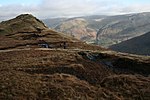Greenside Mine (sometimes referred to as Greenside Lead Mine) was a successful lead mine in the Lake District of England. Between 1825 and 1961 the mine produced 156,000 long tons (159,000 tonnes) of lead and 1,600,000 ounces (45 tonnes) of silver, from around 2 million tons of ore. During the 1940s it was the largest producer of lead ore in the UK. Unusually for a 19th-century metalliferous mine in Britain there are very full records of its activities, dating back to 1825.
The mine probably opened during the second half of the 1700s but had closed by 1819. In 1825 the Greenside Mining Company was formed and reopened the mine. They made good profits until 1880, when the price of lead fell. Many other lead mines closed at that time, but the company reduced its costs and continued to work Greenside until 1935. Electricity was introduced to the mine in the 1890s, and it became the first metalliferous mine in Britain to use electric winding engines and an electric locomotive. In 1936 the Basinghall Mining Syndicate Ltd. acquired the mine and turned it into a high volume lead producer. The mine closed in 1962 after lead reserves had been exhausted. Just before it closed the mine was used by the Atomic Weapons Research Establishment (AWRE) to conduct an experiment in detecting seismic signals from underground explosions. Fifteen years after the mine closed mine explorers began to visit the upper levels. They cleared the entrances and several roof falls, and today they are able to pass through the mine using an old escape route.
All the ore produced by the mine came from the Greenside Vein, a mineral vein which filled a geological fault running in a north–south direction through the east ridge of Green Side, a mountain in the Helvellyn range. Mining activities traced this fault for a length of 3,900 feet (1,200 m) and to a depth of 2,900 feet (880 m). Four areas of the vein, known as ore shoots, contained galena, an ore of lead which also contained small amounts of silver. At first the ore was mined simply by driving adits into the mountain-side. To access ore at greater depths, two longer levels were driven from lower down but further away, and then a series of shafts were sunk within the mine. The lowest point in the mine was roughly 100 m below sea level, where the surrounding andesite rock rested upon underlying shales in which the fault had not been mineralised.
Two processing mills were built to crush the ore and separate out the galena from it, and the mine had its own smelt mill between 1828 and 1917, but after that it was more economical to sell concentrated galena to a commercial smelter. Machinery in the mine and the mills was powered by the plentiful water supplies in the area, used to drive water wheels and power hydraulic engines, and, after 1890, to generate hydroelectricity. Dozens of carts transported supplies to the mine's remote location, and carried the lead out. In the early 1900s the mine set up its own road haulage business using two steam wagons.
The men who worked at the mine during the 19th century travelled from a wide area, and many stayed each week in the lodging shops (bunkhouses) built at the mine. In time the company built dozens of houses in Glenridding and at Seldom Seen in Glencoynedale where a school was also built. Mining work was carried out by groups of men who took contracts to do specific jobs, and were paid by their results. Those who worked transporting ore out of the mine or processing the ore were paid at weekly rates. The closure of the mine resulted in a major loss of employment in the area.












